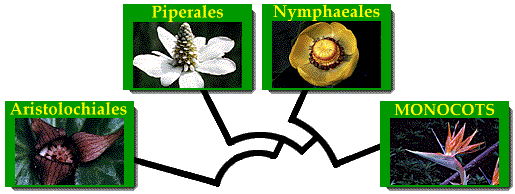

The cladogram above shows one view of paleoherb relationships; this is not clearly settled yet. The three groups of paleoherbs are Aristolochiales (birthwort, Dutchman's pipe), Piperales (pepper vine, lizard's tails), and Nymphaeales (lotus, waterlilies).
Fossil seeds from waterlilies, assigned to the genus Barclayopsis, are known from as early as the Maastrichtian (Late Cretaceous), and fossils from the Eocene and Miocene of leaves and flowers have been found. Additional information will be placed into pages on the individual groups.
You can search the UCMP paleobotany type collection for paleoherbs by entering the name of a genus below:
Our searchable fossil listings include Aristolochia, Aristolochites, Asarum, Nymphaea, and Nymphaeites.
Visit the Tree of Life for current views on the relationships of early angiosperms and paleoherbs.


